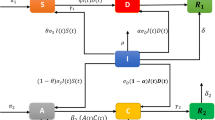Abstract
People of the modern world are using social network Web sites to communicate with others either known or unknown, for getting opinions of others and giving their opinions to others. The post, weblogs, effects or affects human mind, at least for some time. These posts take a part in choosing their decisions and play an important role. But the information present in the post is either information or just misinformation, i.e., just a rumor. People are confused to distinguish these posts in either a correct information or misinformation. It is important to decide whether this is information or just a rumor because it may cause a support of the wrong decision of the whole majority. In this paper, a mathematical framework is presented related to these matters. Firstly, we proposed a mathematical model of news spreading from some posts displayed in an online social network. The development of mathematical models of news propagation uses the epidemiological modeling technique. Then, we proposed criteria of rumor detection and verification for the model. In the case of rumor, a revised model is proposed with media awareness as a control strategy for reducing the rumor spreading.





Similar content being viewed by others
References
Bettencourt LMA et al (2006) The power of a good idea: quantitative modeling of the spread of ideas from epidemiological models. Phys A Stat Mech Appl 364:513–536
Budak C, Agrawal D, El Abbadi A (2011) Limiting the spread of misinformation in social networks. In: Proceedings of the 20th international conference on World wide web. ACM
Cannarella J, Spechler JA (2014) Epidemiological modeling of online social network dynamics. arXiv preprint arXiv:1401.4208
Daley DJ, Kendall DG (1965) Stochastic rumours. IMA J Appl Math 1(1):42–55
Galam S (2003) Modelling rumors: the no plane Pentagon French hoax case. Phys A Stat Mech Appl 320:571–580
Jin F, et al (2013) Epidemiological modeling of news and rumors on twitter. In: Proceedings of the 7th workshop on social network mining and analysis. ACM
Kermark M, Mckendrick AG (1927) Contributions to the mathematical theory of epidemics. Part I. Proc R Soc Lond A Math Phys Eng Sci 115(5):700–721
Maki DP, Thompson M (1973) Mathematical models and applications: with emphasis on the social life, and management sciences. No. 511.8 M3
Newman ME, Forrest S, Balthrop J (2002) Emailnetworks and the spread of computer viruses. Phys Rev E 66(3):035101
Nekovee M et al (2007) Theory of rumour spreading in complex social networks. Phys A Stat Mech Appl 374.1:457–470
Nizamani S, Memon N, Galam S (2014) From public outrage to the burst of public violence: an epidemic-like model. Phys A Stat Mech Appl 416:620–630
Qazvinian V, et al (2011) Rumor has it: Identifying misinformation in microblogs. In: Proceedings of the conference on empirical methods in natural language processing. Association for Computational Linguistics
Shah D, Zaman T (2011) Rumors in a network: Who’s the culprit? IEEE Trans Inf Theory 57(8):5163–5181
Sahu GP, Dhar J (2012) Analysis of an SVEIS epidemic model with partial temporary immunity and saturation incidence rate. Appl Math Model 36(3):908–923
Sahu GP, Dhar J (2015) Dynamics of an SEQIHRS epidemic model with media coverage, quarantine and isolation in a community with pre-existing immunity. J Math Anal Appl 421(2):1651–1672
Vosoughi S (2015) Automatic detection and verification of rumors on Twitter. Dissertation, Massachusetts Institute of Technology
Wu S, et al (2013) Arrival and departure dynamics in social networks. In: Proceedings of the sixth ACM international conference on Web search and data mining. ACM
Zanette DH (2002) Dynamics of rumor propagation on small-world networks. Phys Rev E 65(4):041908
Zhao X, Wang J (2013) Dynamical model about rumor spreading with medium. Discret Dyn Nat Soc 2013:586867
Author information
Authors and Affiliations
Corresponding author
Rights and permissions
About this article
Cite this article
Dhar, J., Jain, A. & K. Gupta, V. A mathematical model of news propagation on online social network and a control strategy for rumor spreading. Soc. Netw. Anal. Min. 6, 57 (2016). https://doi.org/10.1007/s13278-016-0366-5
Received:
Revised:
Accepted:
Published:
DOI: https://doi.org/10.1007/s13278-016-0366-5




